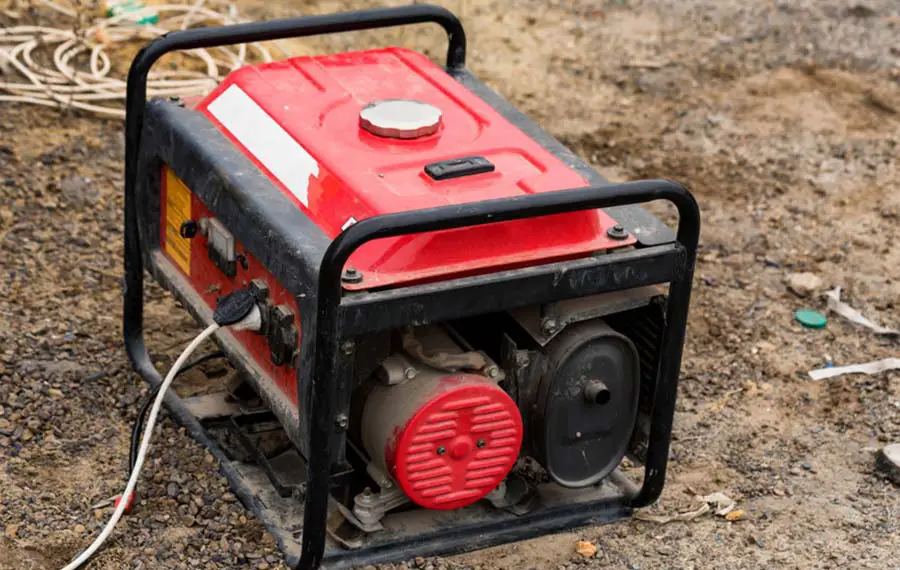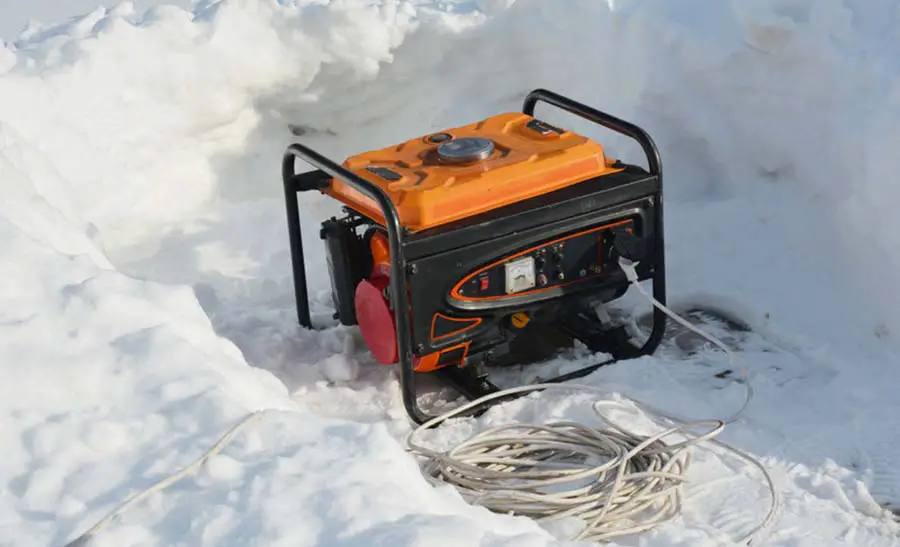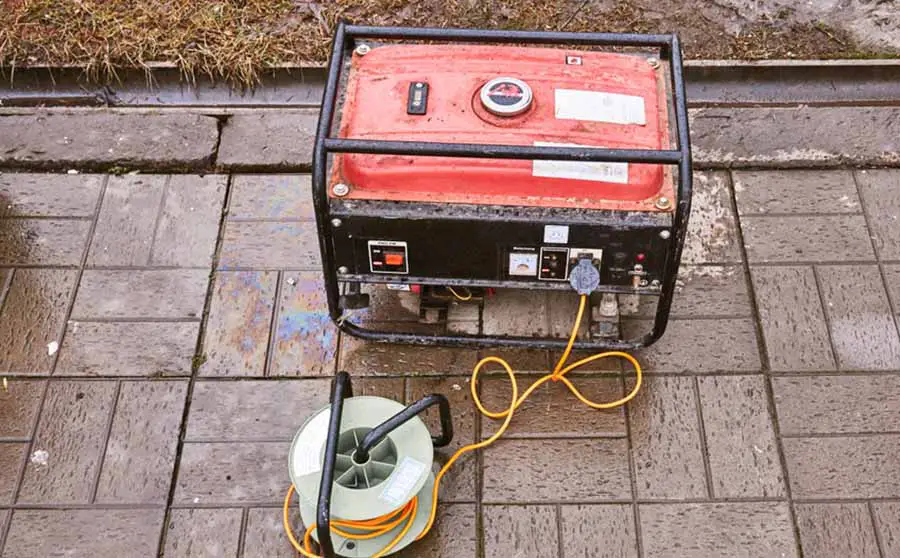
There is nothing as relaxing as a day where it is raining, and the weather is nice and calming, allowing you to listen to the pitter, patter of water on the roof. However, nothing can make that relaxing day turn into the most stressful situation as when you remember the generator is still outside.
If your generator gets wet without being completely submerged, you can usually dry it using compressed air or hot air. If your generator gets very wet or completely submerged, you will need to disassemble, dry, and reassemble every piece in your generator to ensure there is no lasting water damage.
There are multiple ways that your generator can get wet, with most systems being quite easy to dry off when it does eventually get wet. Further, most standby and backup generators will already have covers to protect them, but sometimes some leaks require you to get the machine dried out.
How to Dry Off a Generator After It Gets Wet
Before focusing on the worst-case scenarios or preventing the generators from getting wet, let’s look at what you must do to dry a generator off. We have seen several people make the mistake of assuming they can run their generator when it is entirely wet; however, this is not true.
There are different ways of drying off a generator, each having a different effect on the system, with some being easy to do while others can pose a problem. There are specific ways of drying some generators, with some casings and sensitive parts not always working well with the hotter air.
Hot Air
This is the easiest way to get rid of water that has covered your generator, whether because of rain, someone pressure washing the system, or a leak. You should not use a heat gun to do this as it will melt the plastic; a heater would work best as it covers a broader area and will not melt the plastic.
It may sound odd drying your generator using a heater, but it will prevent the machine from being damaged when in operation. When a generator has gotten wet, it can be tricky to start, as there can be water on the wires that will cause short circuits.
Cold Air
Air movement will help water evaporate; this includes pointing a set of fans towards a generator that has gotten wet. Further, you can use a clean leaf blower to provide a blast of air, ensuring that the entire generator is being blasted dry.
We have seen many people who found their generators to be completely soaked and then not even dry them out. However, if you have a few fans, you can put the machine somewhere it won’t get more water on it and start drying it out with a blast of dry, cold air.
Load Drying
The most common way that a generator may be dried is once it has been rained on, spilled on, or for most other scenarios, that it has gotten wet. However, if the generator is already running or if you are sure the wires are not wet, you can start the machine up to start heating up.
The engine will easily reach high enough temperatures within an hour to be hot enough to make most water on the machine completely evaporate. It is safe to store the generator somewhere it can stay dry; however, repeatedly doing this will cause metal and steel parts to start rusting.
Compressed Air
Another effective way to get your generator to be bone dry within a few minutes is to use compressed air to blast all the water off the machine. We know this is not always an option as not everyone has an air compressor; however, it should be a basic part of your toolbox.
We recommend spraying in every nook and cranny while doing this and wearing a pair of safety glasses; it will launch the water at high speeds. However, compressed air is easily one of the best and effective ways to get your generator to be completely dry without leaving it to leave the generator in the sun.
What Happens When a Generator Is Run in The Rain or Snow?

Now that we know how to dry a generator in the rain or snow, we need to look at what will happen when the generator does get wet. Most of the time, the damage will not be too bad, with most generators easily able to handle being wet once or twice throughout their lives.
However, when the water and snow do become too extreme, several things will start to happen to the machine. Each of these will take a bit longer to take place, with some easily avoidable with a paper towel and other times not at all being easy to predict.
Shorting
The worst thing that can happen without warning to your generator when it gets wet is the machine shorting out. This can occur when water enters the fuse box, the alternator, or gets on wires that cause an immediate system failure.
The safety systems will often instantly turn the generator off when a short has been detected, with the fuses inside your home also turning off. Usually, shorting from rainwater with larger machines like a generator will not destroy the entire machine but damage a few failsafe parts.
Rusting
The long-term damage that will happen to your generator that can cause it to die completely is rust from the rain or snow. As acid rain levels increase, metals will start to rust much faster, with generators being susceptible to becoming entirely inoperable as they become more and more rusted.
You may find that your generator has surface rust because of the humidity in your area, whereas rust that develops on the engine is much worse. Engines are usually solid metal or aluminum blocks that will rust quickly and cause seals to be damaged as the engine is no longer the right shape.
Damage
Water in the oil of your generator is one of the worst things that it can experience, and usually, the only way this can happen, short of complete seal failure, is through the engine’s intake. Water can destroy an engine from the inside as the oil fails and the water starts to cause rust.
You must always ensure that the intake of your generator can breathe in fresh, dry air, even when half the machine is somehow underwater. We always recommend that you move the intake that you have much higher than the machine itself when you can, allowing for constant fresh air.
Surging
This is the much more complicated problem that water on and in your generator can cause; as the system begins to fail from water, surging will become a problem. A slowly short-circuiting generator will also have surges, with the control over the amount of power changing.
You may see that the lights are going brighter or that some appliances that have motors become oddly loud as the generator surges. If you see any strange behavior from the appliances and lights in your house while running on the generator, you must shut it down and disconnect it as fast as possible.
Eventual Damage
We include this because it is something that few people consider, but also because it is not something that will cause the death of the generator. If the frame of your generator is always in the rain or snow, it will start to rust, becoming unusable as the metals start to fall away.
This won’t cause an immediate issue but can cause the system to be out of order for several days or hours if not fixed in time. While the frames for generators are easy to build, one that has rusted away completely may not be so easy to remove, usually leaving you without power for days.
What To Do If Your Generator Is Completely Submerged?
While a light rain or just some snow around the generator is relatively easy to fix, there are times when something much worse happens to your machine. This may be because of a flash flood that has overtaken your suburb, a storm causing problems, or even rare cases of basement storage flooding.
You will need to do much more than simply drying off the top layer of the water on the machine, with most machines that are completely submerged needing a lot more. We have talked to several people that work on generators, and they have the steps sorted out for when the worst does happen.
1. Dry Out the Generator
The first step will be to leave the generators to drain all water that may be stuck, putting it somewhere it will not get more water. Usually, leaving the machine for just one or two days will thoroughly dry the surfaces, making it easier to disassemble in the next step.
We need to point out that you will have to dry out each generator piece as you disassemble the machine. You cannot simply put it back together and hope that everything will work once you finish. Everything that goes back in needs to have absolutely zero moisture on it.
2. Disassemble the Generator
The most arduous part of the process is to disassemble each part of your generator, getting everything apart, even if it is something small and unassuming. Every part of the generator needs to be completely disassembled, with the electric boxes included.
Your alternator and engine also need to be in parts, which can be extremely intimidating, as it is challenging to do. However, if done slowly, carefully, and by keeping all the nuts and bolts at the right spots, most people should do this properly.
3. Reseal All Seals On the Generator
There are several seals on your generator, with the alternator and engine having specific types of seals that you must remember. We recommend that you always replace every seal on the generator after submersion to ensure that it won’t be a problem if anything gets scratched.
We have seen several people assume that seals are not as important or that they will work fine after being removed; however, it is not accurate. Seals can be the difference between a machine that continues to work forever or a machine that never starts up again.
4. Regrease Any Generator Parts
Grease is like oil, but on parts that move more and cannot be filled with oil to keep everything turning and operating well. Everything that had grease on it before you will need to put grease on again, taking special care to use the right type of grease on electric components.
Doing so will ensure that the moving parts can continue moving and that the generator does not sustain damage due to its movement. Usually, you can use the same grease throughout the engine, as all the engine parts are not electric.
5. Reassemble the Generator
Once everything is dried, resealed, and regreased, you need to do the most complicated part of the entire process. Reassembling the generator is always complicated because you are building both an engine and a small power plant, making everything more complicated.
We recommend doing this with a friend as it will be easier, and many times they can help move the heavier objects into the right spots. We have seen many people who try to do this on their own and completely fail, forget some parts, or make mistakes.
6. Replace Oil and Test the Generator
Before starting the generator again, you need to drain and replace the oil in your generator. Then once you’ve filled the oil pan, you should start testing the generator, showing that it does work and provides power.
We recommend not running it completely when first starting; instead, starting it up and then checking everything. Once you are sure the machine can properly work, you can continue to use the generator as usual, as you’ve now completely rebuilt it.
How Do You Protect a Generator from Rain or Snow?

If you buy a standby or backup generator, it will already have all the necessary protection from the weather; you will have to install everything correctly. However, we know that many people may have portable generators they want to convert.
You may also have an older standby generator that needs new protection or housing, so it is essential to learn how to prevent the system from getting wet. When done correctly, you can easily and comfortably have a generator that never sees a drop of water.
Roofing
If your generator only stands around two to four feet high, then a roof around six feet high that overhangs the generator by a foot on all sides ensures it will always stay dry. Even in the worst of storms, it should be relatively dry; the machine’s sides will be the only parts when it gets wet.
However, this still leaves the generator open to getting wet when high winds and storms start working together, with bugs, sand, and dust still damaging it. This should only be a solution to keeping your generator dry if you have no other way of keeping it safe and dry.
Full Cover
The solution used for home standby generators is to have them fully covered, with a plastic or fiberglass shell that fits perfectly around the generator. You can usually buy these shells at most hardware stores or through the manufacturer of the generator.
You can build a custom cover made out of treated wood or even repurpose pool covers if you have a portable generator. The only requirement for these covers is that they are a certain distance from your house and can provide enough venting and cooling for the machine to operate.
Build a Base and House
As part of all standby generator housing, you will have to build a solid cement base where you can bolt down the generator. If you want to keep your portable generator dry or move your standby generator, you need to install a base first, then build the housing onto that base for the system.
We always recommend that you do this anyway, as keeping a generator on grass, dirt, or sand will have it become dirty and clogged long before it should. Having a good, solid space to store the generator will mean that it does not simply become too dirty to use when in storage.
Insulate Cables
If you think you may have to use your generator when it is raining or snowing, and you have no way to protect it, we recommend making it water-resistant. This involves ensuring the cables, intakes, and exhaust are appropriately insulated, allowing the system to operate even in the rain.
Doing this will not guarantee that the system is working perfectly throughout any rainstorm or snowy days; however, it does make the chances better. You will still need to dry the generator off entirely when it is taken into storage, ensuring that every part of it is dry to prevent rusting and other damage.
Have a Rain Tarp
The unfortunate truth is that not everyone can magically have the perfect place to store their generator. We have seen many people with no place to store their generator and end up placing it somewhere that exposes it to everything mother nature can throw at it.
Covering the generator completely with a rain tarp strapped over it will also help keep the machine completely dry when raining or snowing. You will have to remove the tarp when the generator is running, but it will help to keep the worst weather away from your generator.
Conclusion
When your generator gets wet because of light rain, it is not the end of the world, and apart from some rust, nothing bad will happen. However, anything worse will require that you properly dry the generator to prevent it from being broken, with the worst-case scenario being a complete rebuild.
Remember, companies don’t build generators under the assumption that they will never get wet; instead, manufacturers make them able to handle at least a little bit of water!

